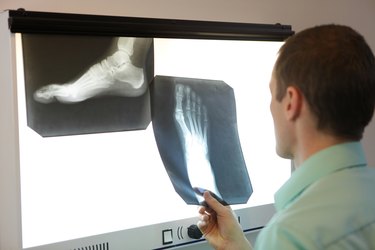
Pain on the inside of your ankle is relatively common, and is often associated with flat feet. This pain may indicate an injury to a very strong tendon known as your posterior tibial tendon or deltoid ligaments, either through overuse or through an acute injury.
Because this tendon is hard to injure without a fracture or a serious foot issue, it's best to get the injury checked out by a doctor even if the pain you experience is relatively mild.
Video of the Day
Video of the Day
The Posterior Tibial Tendon
Your ankle is an important weight-bearing joint for the body, and is held together with large clusters of tendons that attach to the muscles in your calf and foot. These muscles pull the tendons of your ankle, enabling the spring-like motion of your foot during a run.
Your posterior tibial tendon, also known as the deltoid ligaments (not to be confused with the deltoid muscle in the shoulder) is located on the inside of the ankle. This tendon is one of the largest in the ankle, and is also one of the least likely to be injured. It's primarily responsible for raising the arch of your foot and stabilizing the ankle joint.
Read More: How to Best Help a Sprained Ankle
Understanding the Injury
It's highly unlikely that you'll tear your posterior tibial tendon without a serious injury. Your fibula bone (the bony protrusion on the outside of your ankle) tends to prevent any over-stretching in this particular tendon. Your ankle simply can't rotate far enough outwards to strain the tendon.
A tear is unlikely also because the tendons at the opposite side of the ankle aren't as strong, so you'll more than likely strain them first by rolling your ankle inwards.
Tibialis posterior syndrome is a more common cause of pain on the inside of your ankle, which results from slow-onset inflammation and soreness in the posterior tibial tendon. It's commonly associated with flat feet, since the tendon is responsible for stabilizing the foot and raising the arch while you run.
How This Injury Occurs
Tibialis posterior syndrome is very common, and occurs from overuse or repeated impact. For runners, it may slowly tear over time from the repeated impact of your step, allowing the arch to collapse over time.
High-impact sports like basketball or tennis may increase the likelihood for strain. You'll notice pain or soreness, and you may or may not notice associated swelling.
Pain may also be the result of an acute injury, like a bad fall. This tendon is most commonly injured if you fracture your ankle. A bad tear in this tendon is usually associated with tears to other surrounding tendons, or a fracture in the ankle joint itself.

Treating Tibialis Posterior Syndrome
If you experience pain on the inside of your ankle, discontinue running immediately, as this can aggravate the affected area and slow the healing process. Rest the joint, apply ice and compression and consult a doctor or physical therapist for an X-ray to rule out any associated injuries.
Treatment of tibialis posterior syndrome may include the use of a custom orthotic to address flat-footedness, and many doctors will recommend an ankle brace or physical therapy as well. Very few people who fracture their ankle manage to tear this particular tendon in the process. If there is a bad tear, surgery may be necessary for a full recovery.
- American Academy of Orthopedic Surgeons: Posterior Tibial Tendon Dysfunction
- Strategies in Trauma and Limb Reconstruction: The Diagnosis and Treatment of Deltoid Ligament Legions in Supination-External Rotation Ankle Fractures: A Review
- American Journal of Roentgenology: Ankle Ligaments on MRI: Appearance of Normal and Injured Ligaments
- Cambridge Foot and Ankle Clinic: Injury of the Ankle Ligaments